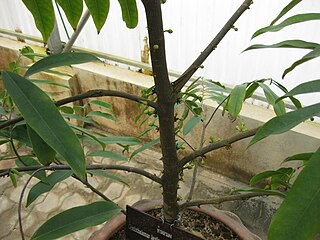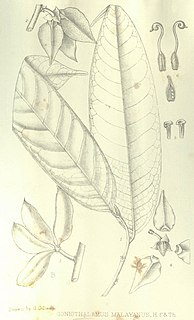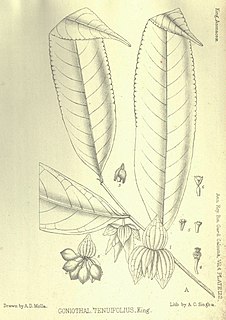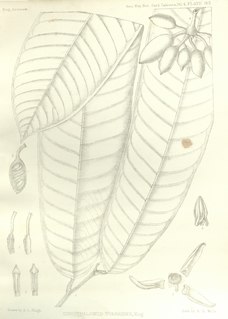Pseuduvaria cerina is a species of plant in the Annonaceae family. It is endemic to Peninsular Malaysia. James Sinclair, the Scottish botanist who first formally described the species, named it after its waxy yellow inner petals.
Goniothalamus aurantiacus is a species of plant in the family Annonaceae. It is native to Thailand. Piya Chalermglin and Richard M.K. Saunders, the botanists who first formally described the species, named it after its orange colored inner petals.

Goniothalamus calvicarpus is a species of plant in the family Annonaceae. It is native to China, Laos and Thailand. William Grant Craib, the British botanist who first formally described the species, named it after its hairless fruit.
Goniothalamus elegans is a species of plant in the family Annonaceae. It is native to Thailand and Vietnam. Suzanne Jovet-Ast, the French botanist who first formally described the species, named it after its elegant thin, flexible leaves.
Goniothalamus expansus is a species of plant in the family Annonaceae. It is native to Thailand and Vietnam. William Grant Craib, the British botanist who first formally described the species, named it after its exanded stigmas.

Goniothalamus laoticus is a species of plant in the family Annonaceae. It is native to Laos and Thailand. It was originally described by the French botanists Achille Eugène Finet and François Gagnepain using the basionym Mitrephora laotica. In Thailand it is commonly called Khao Lam-dong and is used as a traditional medicine.
Goniothalamus latestigma is a species of plant in the family Annonaceae. It is native to Myanmar and Thailand. Cecil Ernest Claude Fischer, the botanist who first formally described the species, named it after its broad stigmas.

Goniothalamus macrophyllus is a species of plant in the family Annonaceae. It is native to Borneo, Java, the Malay Peninsula, Sumatra and Thailand. Carl Ludwig Blume, the German-Dutch botanist who first formally described the species using the basionym Unona macrophylla, named it after its large leaves. It is commonly called Penawar Hitam in the Malaya Peninsula, Ki Cantung in Indonesia, Limpanas Putih in Brunei, and Chin Dok Diao in Thailand.
Goniothalamus maewongensis is a species of plant in the family Annonaceae. It is native to Thailand. Richard M.K. Saunders and Piya Chalermglin, who first formally described the species, named it after the Mae Wong National Park in Thailand where the type specimen was collected.

Goniothalamus malayanus is a species of plant in the family Annonaceae. It is native to Borneo, the Malay Peninsula, the Nicobar Islands, Sumatra and Thailand. Joseph Dalton Hooker and Thomas Thomson, the British botanists who first formally described the species, named it after part of its habitat range, British Malaya.
Goniothalamus nitidus is a species of plant in the family Annonaceae. It is native to Borneo. Elmer Drew Merrill, the American botanist who first formally described the species, named it after its shining leaves.

Goniothalamus ridleyi is a species of plant in the family Annonaceae. It is native to Borneo, Peninsular Malaysia, Sumatra and Thailand. George King, who first formally described the species, named it after the English botanist Henry Nicholas Ridley who collected the specimen King examined.
Goniothalamus rongklanus is a species of plant in the family Annonaceae. It is native to Thailand. Richard Saunders and Piya Chalermglin first formally described the species and named it after Phu Hin Rong Kla National Park in Thailand.
Goniothalamus sawtehii is a species of plant in the family Annonaceae. It is native to Myanmar and Thailand. Cecil Ernest Claude Fischer the botanists who first formally described the species, named it in honor of Maung Saw Teh, a plant collector who provided the specimen examined by Fischer.

Goniothalamus scortechinii is a species of plant in the family Annonaceae. It is native to Peninsular Malaysia and Thailand. George King, the British botanist who first formally described the species, named it in honor of Benedetto Scortechini, an Italian priest and member of the Linnean Society of London and New South Wales who collected many important botanical samples in Peninsular Malaysia.

Goniothalamus tapis is a species of plant in the family Annonaceae. It is native to Peninsular Malaysia, Sumatra, and Thailand. Friedrich Anton Wilhelm Miquel, the Dutch botanists who first formally described the species, named it after a local vernacular name, Kajoe-tapis, from Pariaman Sumatra where the specimen he examined was found.

Goniothalamus tenuifolius is a species of plant in the family Annonaceae. It is native to Peninsular Malaysia, Thailand and Vietnam. George King, the British botanist who first formally described the species, named it after its slender leaved foliage.
Goniothalamus tortilipetalus is a species of plant in the family Annonaceae. It is native to Peninsular Malaysia and Thailand. Murray Ross Henderson, the Scottish botanist who first formally described the species, named it after its twisted petals.

Goniothalamus uvarioides is a species of plant in the family Annonaceae. It is native to Peninsular Malaysia and Thailand. George King, the British botanist who first formally described the species, named it after its fruit which he thought resembled those of the genus Uvaria more than those of Goniothalamus.
Goniothalamus undulatus is a species of plant in the family Annonaceae. It is native to Thailand and Vietnam. Henry Nicholas Ridley, the English botanist who first formally described the species, named it after the wavy edges of its leaves.








